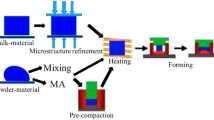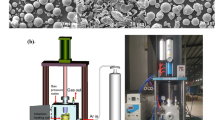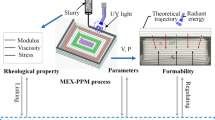Abstract
For the past 2 years, interest in manufacturing technologies based on micro-fluidic systems has been continuously increasing. Today, micro-fluidic systems are used in numerous biomedical and pharmaceutical applications. Micro-fluidics cannot be thought about separately without advances in micro- and nano-fabrication. Investigations based on experiments, finite element modelling and simulations of powder hot embossing process (PHE) were performed to optimise the sintering step and processing parameters of micro-fluidic components. The model pertaining to thermo-elasto-viscoplastic behaviour was identified for 316L stainless steel powders. In this regard, different material properties such as sintering stress, bulk, and shearing viscosities were identified by inverse analysis from present dilatometer measurements using beam-bending and free sintering tests. The identification of materials was performed for various powder volume loadings and kinetic rates for different 316L elaborated feedstock, and the parameters were obtained as functions of relative density. The initial inhomogeneity due to the PHE process has been taken into account in the sintering simulation, as it affects the final shrinkage of the sintered components. The solid-state sintering simulations were investigated for various final sintering temperatures and kinetic rates to obtain high and homogeneous relative density distributions, achieve isotropic shrinkage and optimise the sintering process parameters. The numerical simulations were realised based on the identified parameters on a 3D micro-structured specimen with an associated rectangular plate support elaborated by PHE; this allowed a comparison between the numerical predictions and the experimental results for the sintering stage. The finite element simulation results of the sintering stage with a micro-fluidic structured component at a high final temperature (1360 °C) are in excellent agreement with the results of the experiments. The comparison of the simulation and experimental results validated the identified and implemented physical model and proposed methodologies.
Similar content being viewed by others
References
Liu C-H, Chen W, Su W, Sun C-N (2015) Numerical and experimental analysis of the automated demolding process for PDMS microfluidic devices with high-aspect ratio micropillars. Int J Adv Manuf Technol 80:401–409
Ohno K, Tachikawa K, Manz A (2008) Microfluidics: applications for analytical purposes in chemistry and biochemistry. Electrophoresis 29:4443–4453
Chen P-C, Pan C-W, Lee W-C, Li K-M (2014) An experimental study of micromilling parameters to manufacture microchannels on a PMMA substrate. Int J Adv Manuf Technol 71:1623–1630
Jáuregui AL, Siller HR, Rodríguez CA, Elías-Zúñiga A (2010) Evaluation of micromechanical manufacturing processes for microfluidic devices. Int J Adv Manuf Technol 48:963–972
Armillotta A, Baraggi R, Fasoli S (2014) SLM tooling for die casting with conformal cooling channels. Int J Adv Manuf Technol 77(1):573–583
Li JM, Liu C, Peng J (2008) Effect of hot embossing process parameters on polymer flow and microchannel accuracy produced without vacuum. J Mater Process Technol 207:163–171
Ou H, Sahli M, Gelin J-C, Barrière T (2014) Experimental analysis and finite element simulation of the co-sintering of bi-material components. Powder Technol 268:269–278
Raza M-R, Sulong A-B, Muhamad N, Akhtar M-N, Rajabi J (2015) Effects of binder system and processing parameters on formability of porous Ti/HA composite through powder injection moulding. Mater Des 87:386–392
Sahli M, Gelin J-C, Barriere T (2013) Characterisation and replication of metallic microfluidic devices using three different powders processed by hot embossing. Powder Technol 246:284–302
Kurgan N (2013) Effects of sintering atmosphere on microstructure and mechanical property of sintered powder metallurgy 316L stainless steel. Mater Des 52:995–998
Sahli M, Gelin J-C, Barrière T (2015) Replication of microchannel structures in WC–co feedstock using elastomeric replica moulds by hot embossing process. Mater Sci Eng C 55:252–266
Choi J-P, Lee G-Y, Song J-I, Lee W-S, Lee J-S (2015) Sintering behavior of 316L stainless steel micro–nanopowder compact fabricated by powder injection moulding. Powder Technol 279:196–202
Rajabi J, Muhamad N, Sulong A-B, Fayyaz A, Raza M-R (2014) The effect of nano-sized stainless steel powder addition on mechanical and physical properties of micropowder injection molded part. Mater Des 63:223–232
Kurgan N (2014) Effect of porosity and density on the mechanical and microstructural properties of sintered 316L stainless steel implant materials. Mater Des 55:235–241
Xie F, He X, Cao S, Qu X (2013) Structural and mechanical characteristics of porous 316L stainless steel fabricated by indirect selective laser sintering. J Mater Process Technol 213:838–843
Coble RL (1961) Sintering crystalline solids. I. Intermediate and final state diffusion models. J Appl Phys 32:787–792
German RM (1996) Sintering theory and practices. John Wiley, New York
R. M. German (1996) Sintering theory and practice, ISBN 0-471-05786-X. Wiley-VCH, 568
Wakai F (2013) Mechanics of viscous sintering on the micro- and macro-scale. Acta Mater 61:239–247
Gasik M, Baosheng Z (2000) A constitutive model and FE simulation for the sintering process of powder compacts. Comput Mater Sci 8:93–101
Heaney DF, Spina R (2007) Numerical analysis of debinding and sintering of MIM parts. J Mater Process Technol 191:385–389
Reiterer M, Kraft T, Janosovits U, Riedel H (2004) Finite element simulation of cold isostatic pressing and sintering of SiC components. Ceram Int 30:177–183
Bruchon J, Pino-Munoz D, Valdivieso F, Drapier S (2010) Finite element simulation of mass transport during sintering of a granular packing. Part I. Surface and lattice diffusions. J Am Ceram Soc 13:1–23
Khoei AR (2002) Numerical simulation of powder compaction processes using an inelastic finite element analysis. Mater Des 23:523–529
Mamen B, Barriere T, Gelin JC (2013) Investigations on thermal debinding process for fine 316L stainless steel feedstocks and identification of kinetic parameters from coupling experiments and finite element simulations. Powder Technol 235:192–202
German RM (2002) Computer modeling of sintering processes. Int J Powder Metall 38:48–66
Mamen B, Song J, Barriere T, Gelin J-C (2015) Experimental and numerical analysis of the particle size effect on the densification behaviour of metal injection moulded tungsten parts during sintering. Powder Technol 270:230–243
Kraft T, Riedel H (2004) Numerical simulation of solid state sintering: model and application. J Eur Ceram Soc 24:345–361
Tsvelikh A, Thompson W, Easton A, Freshwater I (1995) A geometrical finite element model of the sintering process of advanced ceramics. Comput Mater Sci 3:457–464
Ozkan N, Briscoe BJ (1994) Rheological analysis of ceramic pastes. J Eur Ceram Soc 14:143–151
Ozkan N, Briscoe BJ (1997) Overall shape of sintered alumina compacts. Ceram Int 23:521–536
German RM, Lathrop JF (1978) Simulation of spherical powder sintering by surface diffusion. J Mater Sci 13:921–929
Bouvard D, McMeeking RM (1996) Deformation of interparticle necks by diffusion controlled creep. J Am Ceram Soc 79:666–672
Shimosaka A, Sawai T, Hidaka J (1995) Computer simulation of the initial stage sintering of particles. J Soc Powder Technol 32:668–674
Ch’ng HN, Pan J (2007) Sintering of particles of different sizes. Acta Mater 55:813–824
Pan J, Cocks ACF, Kucherenko S (1997) Finite element formulation of coupled grain boundary and surface diffusion with grain-boundary migration. Proc Roy Soc A 453:2161–2184
Wang YU (2006) Computer modeling and simulation of solid-state sintering: a phase field approach. Acta Mater 54:953–961
Asp K, Agren J (2006) Phase-field simulation of sintering and related phenomena-a vacancy diffusion approach. Acta Mater 54:1241–1248
Nomoto S (2010) Application of multi-phase-field method to sintering. JSME 23th Computational Mechanics Division Conference 23:105–106
Wang C, Cheng L, Zhao Z (2010) FEM analysis of the temperature and stress distribution in spark plasma sintering: modelling and experimental validation. Comput Mater Sci 49:351–362
Muñoz S, Anselmi-Tamburini U (2010) Temperature and stress fields evolution during plasma sintering processes. J Mater Sci 45:6528–6539
Song J, Gelin JC, Barrière T, Liu B (2006) Experiments and numerical modelling of solid state sintering for 316L stainless steel components. J Mater Process Technol 177:352–355
Barriere T, Liu B, Gelin J-C (2003) Determination of the optimal process parameters in metal injection molding from experiments and numerical modeling. J Mater Process Technol 144:636–644
Schoenberg SE, Green DJ, Segall AE, Messing GL, Grader AS, Halleck PM (2006) Stresses and distortion due to green density gradients during densification. J Am Ceram Soc 89:3027–3033
Toussaint F, Bouvard D, Tenaud P, Di Marcello E (2004) Experimental and numerical analysis of the deformation of ferrite segments during sintering. J Mater Process Technol 147:72–78
Yu PC, Li QF, Fuh JYH, Li T, Lu L (2007) Two-stage sintering of nano-sized yttria stabilized zirconia process by powder injection moulding. J Mater Process Technol 192:312–318
Skorokhod VV, Olevskii EA, Shtern MB (1993) Continuum theory of sintering. I. Phenomenological model. Analysis of the effect of external forces on the kinetics of sintering. Powder Metall Met Ceram 32:21–26
Sofronis P, McMeeking RM (1992) Creep of power-law material containing spherical voids. J Appl Mech 59:88–95
Olevsky EA (1998) Theory of sintering: from discrete to continuum. Mater Sci Eng 23:41–100
Skorohod VV, Olesvsky EA, Shtern MB (1991) Continnum theory for sintering of the porous bodies: model and application. Sci Sinter 23:79–91
Gasik M, Zhang B (2000) A constitutive model and FE simulation for the sintering process of powder compacts. Comput Mater Sci 18:93–101
Bordia RK, Scherer GW (1988) On constrained sintering. I. Constitutive model for a sintering body. Acta Mater 36:2393–2397
Scherer GW (1979) Sintering inhomogeneous glasses: application to optical waveguides. J Non-Cryst Solids 34:239–256
Peterson A, Agren J (2004) Constitutive benhavior of WC–co materials with different grain size sintered under load. Acta Mater 52:1847–1858
Olevsky EA, German RM, Upadhyaya A (2000) Effect of gravity on dimensional change during sintering- Π shape distortion. Acta Mater 48:1167–1180
Loh NH, German RM (1996) Statistical analysis of shrinkage variation for powder injection molding. J Mater Process Technol 59:278–284
German RM (1990) Powder injection molding. MPIF, Princeton
Henrich B, Wonisch A, Kraft T, Moseler M, Riedel H (2007) Simulations of the influence of rearrangement during sintering. Acta Mater 55:753–762
Author information
Authors and Affiliations
Corresponding author
Rights and permissions
About this article
Cite this article
Sahli, M., Mamen, B., Ou, H. et al. Experimental analysis and numerical simulation of sintered micro-fluidic devices using powder hot embossing process. Int J Adv Manuf Technol 99, 1141–1154 (2018). https://doi.org/10.1007/s00170-018-2509-5
Received:
Accepted:
Published:
Issue Date:
DOI: https://doi.org/10.1007/s00170-018-2509-5




